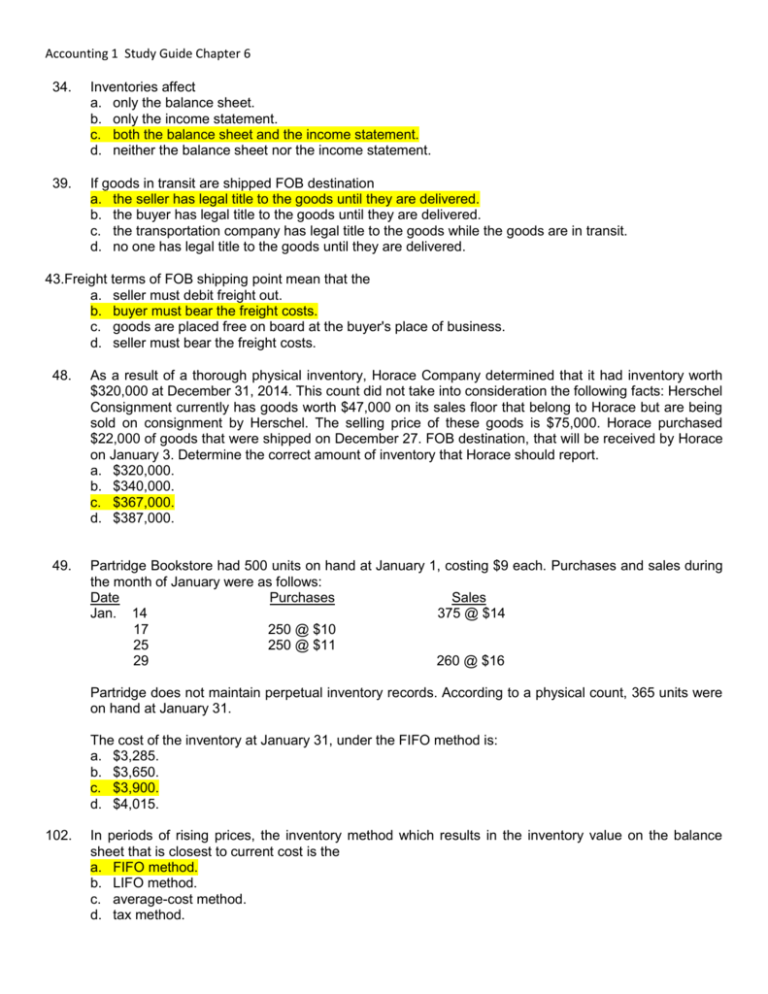Accounting 1 Study Guide Chapter 6 34. Inventories affect a. only
advertisement

Accounting 1 Study Guide Chapter 6 34. Inventories affect a. only the balance sheet. b. only the income statement. c. both the balance sheet and the income statement. d. neither the balance sheet nor the income statement. 39. If goods in transit are shipped FOB destination a. the seller has legal title to the goods until they are delivered. b. the buyer has legal title to the goods until they are delivered. c. the transportation company has legal title to the goods while the goods are in transit. d. no one has legal title to the goods until they are delivered. 43.Freight terms of FOB shipping point mean that the a. seller must debit freight out. b. buyer must bear the freight costs. c. goods are placed free on board at the buyer's place of business. d. seller must bear the freight costs. 48. As a result of a thorough physical inventory, Horace Company determined that it had inventory worth $320,000 at December 31, 2014. This count did not take into consideration the following facts: Herschel Consignment currently has goods worth $47,000 on its sales floor that belong to Horace but are being sold on consignment by Herschel. The selling price of these goods is $75,000. Horace purchased $22,000 of goods that were shipped on December 27. FOB destination, that will be received by Horace on January 3. Determine the correct amount of inventory that Horace should report. a. $320,000. b. $340,000. c. $367,000. d. $387,000. 49. Partridge Bookstore had 500 units on hand at January 1, costing $9 each. Purchases and sales during the month of January were as follows: Date Purchases Sales Jan. 14 375 @ $14 17 250 @ $10 25 250 @ $11 29 260 @ $16 Partridge does not maintain perpetual inventory records. According to a physical count, 365 units were on hand at January 31. The cost of the inventory at January 31, under the FIFO method is: a. $3,285. b. $3,650. c. $3,900. d. $4,015. 102. In periods of rising prices, the inventory method which results in the inventory value on the balance sheet that is closest to current cost is the a. FIFO method. b. LIFO method. c. average-cost method. d. tax method. 50. Partridge Bookstore had 500 units on hand at January 1, costing $9 each. Purchases and sales during the month of January were as follows: Date Purchases Sales Jan. 14 375 @ $14 17 250 @ $10 25 250 @ $11 29 260 @ $16 Partridge does not maintain perpetual inventory records. According to a physical count, 365 units were on hand at January 31. The cost of the inventory at January 31, under the LIFO method is: a. $3,285. b. $3,650. c. $3,900. d. $4,015. 54. Cost of goods sold is computed from the following equation: a. beginning inventory – cost of goods purchased + ending inventory. b. sales – cost of goods purchased + beginning inventory – ending inventory. c. sales + gross profit – ending inventory + beginning inventory. d. beginning inventory + cost of goods purchased – ending inventory. 61. A company purchased inventory as follows: 150 units at $5 350 units at $6 The average unit cost for inventory is a. $5.00. b. $5.50. c. $5.70. d. $6.00. 119. Under the lower-of-cost-or-market basis in valuing inventory, market is defined as a. current replacement cost. b. selling price. c. historical cost plus 10%. d. selling price less markup. 121. Alfalfa Company developed the following information about its inventories in applying the lower-of-costor-market (LCM) basis in valuing inventories: Product Cost Market A $112,000 $120,000 B 80,000 76,000 C 155,000 162,000 If Alfalfa applies the LCM basis, the value of the inventory reported on the balance sheet would be a. $343,000. b. $347,000. c. $358,000. d. $362,000. BE 182 Flaherty Company had beginning inventory on May 1 of $12,000. During the month, the company made purchases of $40,000 but returned $2,000 of goods because they were defective. At the end of the month, the inventory on hand was valued at $15,500. Calculate cost of goods available for sale and cost of goods sold for the month. Beginning inventory $12,000 Net purchases ($40,000 – $2,000) +38,000 Goods available for sale $50,000 Ending inventory – 15,500 Cost of goods sold $34,500 BE 189 At December 31, 2014, the following information was available for Deen Company: ending inventory $22,600; beginning inventory $21,400; cost of goods sold $171,000; and sales revenue $430,000. Inventory Turnover = $171,000 ÷ [($21,400 + $22,600) ÷ 2] = 7.8 times Days in Inventory = 365 ÷ 7.8 = 46.8 days Ex. 195 Ford Co. uses a periodic inventory system. Its records show the following for the month of May, in which 75 units were sold. May 1 Inventory 15 Purchases 24 Purchases Totals Units 35 30 40 105 Unit Cost $ 8 12 13 Total Cost $ 280 360 520 $1,160 Instructions Compute the ending inventory at May 31 and cost of goods sold using the FIFO and LIFO and Weighted Average FIFO Beginning inventory (35 X $8).................................................................. $280 Purchases May 15 (30 X $12) ............................................................................. $360 May 24 (40 X $13) ............................................................................. 520 880 Cost of goods available for sale ............................................................... 1,160 Less: Ending inventory (30 X $13) ........................................................... 390 Cost of goods sold ................................................................................... $770 Date 5/1 5/15 5/24 Units 35 30 10 Proof Unit Cost $ 8 12 13 Total Cost $280 360 130 $ 770 LIFO Cost of goods available for sale ................................................................ Less: Ending inventory (30 X $8) .............................................................. Cost of goods sold .................................................................................... Date Units Proof Unit Cost Total Cost $1,160 240 $ 920 5/24 5/15 5/1 40 30 5 $13 12 8 $520 360 40 $920





